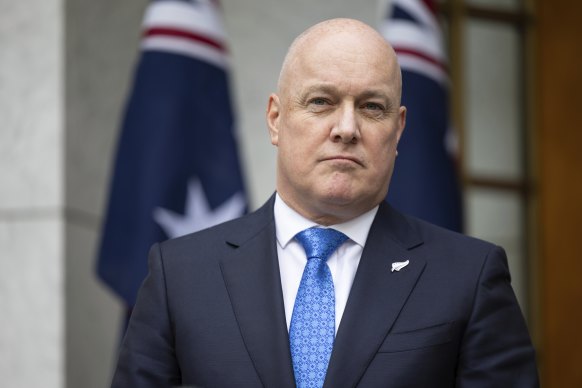
Wellington: On September 25, the Aotearoa, one of just a handful of ships in the Royal New Zealand Navy, sailed through the Taiwan Strait alongside an Australian destroyer. The idea was to demonstrate to China that its claims to sole control of the waterway are invalid under international law. The United States does it several times a year, despite condemnations from China, sometimes with allies such as Canada. Australia does, too. New Zealand has not made such a bold move since 2017.
In an interview with The Economist, Christopher Luxon, New Zealand’s prime minister, notes that, as a small trading nation, New Zealand depends on freedom of navigation. All countries, he says, including China, need to adhere to international law. He plays down the voyage itself: he argues it was just the quickest way for the ship to sail from the East China Sea to the South China Sea.

New Zealand Prime Minister Christopher Luxon.Credit: Alex Ellinghausen
But the Aotearoa’s transit underscores a big shift in New Zealand’s foreign policy under Luxon, who took office as the head of a coalition government in November last year. His “reset”, as he calls it, has two elements. The first is a push to diversify New Zealand’s diplomatic and trade relationships away from its reliance on China, which takes 27 per cent of its exports. This is mostly uncontroversial.
The second is to bring New Zealand into closer alignment with the other four countries in the Five Eyes, an agreement between the US, Australia, Britain, Canada and New Zealand to share intelligence. As part of that, Luxon is prepared to align New Zealand more closely with the US than at any point since the two former allies went their separate ways in 1986. The latter change has provoked one of the most spirited debates in New Zealand on foreign policy since that time.
Loading
New Zealand is the only Five Eyes country that is not a US ally. That is unlikely to change, at least on paper. The US suspended its defence commitments to New Zealand under the ANZUS alliance in 1986 in response to a ban by New Zealand on nuclear weapons in its ports. Because the US navy doesn’t disclose which of its ships are carrying nukes, that made an alliance impossible.
In the years that followed, New Zealand’s governments of the left and right staked out a new foreign policy for the country. They forged deeper diplomatic ties with New Zealand’s closest neighbours, the small island countries of the Pacific, and traded more with a rising Asia. But it was only “semi-aligned” with the West, according to Helen Clark, who served as prime minister from 1999 to 2008. It avoided getting involved with the war in Iraq, but sent special forces to help NATO fight the Taliban in Afghanistan.
It also got rich. In 2008, Clark’s government signed a free-trade agreement with China. The pact, which removed 98 per cent of Chinese tariffs on New Zealand’s exports, spared it the worst effects of the global financial crisis. But most of New Zealand’s exports to China are highly substitutable agricultural goods, making it vulnerable to economic coercion.
And as trade with China grew, so did other links between the two, not all of them benign. Under Labour governments from 2017 to 2023, prompted by intelligence-agency warnings, New Zealand cracked down on Chinese attempts to interfere in its politics. It tightened an investment screening process and banned foreign campaign donations.



























